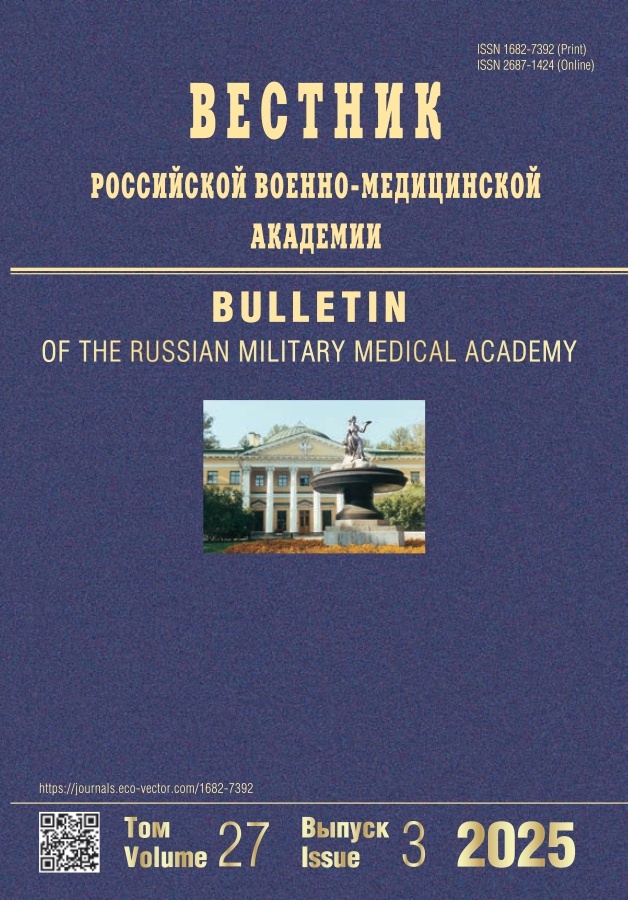Possibilities of use of arc-type discharge low-temperature air plasma of atmospheric pressure for burn wound treatment
- Authors: Zinovyev EV1, Tsygan VN2, Asadulayev MS3, Borisov OV3, Lopatin IM3, Lukyanov SA3, Artsimovich IV3, Paneyakh MB3, Kostyakov DV2, Kravtsov SN2, Zubov VV3, Osmanov KF2
-
Affiliations:
- Военно-медицинская академия им. С.М. Кирова Санкт-Петербургский государственный педиатрический медицинский университет
- Военно-медицинская академия им. С.М. Кирова
- Санкт-Петербургский государственный педиатрический медицинский университет
- Issue: Vol 20, No 2 (2018)
- Pages: 171-176
- Section: Articles
- URL: https://journals.rcsi.science/1682-7392/article/view/12315
- DOI: https://doi.org/10.17816/brmma12315
- ID: 12315
Cite item
Full Text
Abstract
Full Text
##article.viewOnOriginalSite##About the authors
E V Zinovyev
Военно-медицинская академия им. С.М. Кирова Санкт-Петербургский государственный педиатрический медицинский университет
V N Tsygan
Военно-медицинская академия им. С.М. Кирова
M S Asadulayev
Санкт-Петербургский государственный педиатрический медицинский университет
O V Borisov
Санкт-Петербургский государственный педиатрический медицинский университет
I M Lopatin
Санкт-Петербургский государственный педиатрический медицинский университет
Email: forlopatin@yandex.ru
S A Lukyanov
Санкт-Петербургский государственный педиатрический медицинский университет
I V Artsimovich
Санкт-Петербургский государственный педиатрический медицинский университет
M B Paneyakh
Санкт-Петербургский государственный педиатрический медицинский университет
D V Kostyakov
Военно-медицинская академия им. С.М. Кирова
S N Kravtsov
Военно-медицинская академия им. С.М. Кирова
V V Zubov
Санкт-Петербургский государственный педиатрический медицинский университет
K F Osmanov
Военно-медицинская академия им. С.М. Кирова
References
- Алексеев, А.А. Современные методы лечения ожогов и ожо- говой болезни / А.А. Алексеев // Комбустиология. - 1999. - № 1. - С. 1-9.
- Анощенко, Ю.Д. Медико-социальная характеристика больных с ожоговой травмой / Ю.Д. Анощенко // Комбустиология. - 1993. - № 8. - С. 16-17.
- Братийчук, А.Н. Применение аппарата «Плазон» при лечении больных с гнойной хирургической инфекцией в поликлини- ке / А.Н. Братийчук [и др.] // Воен.-мед. жур. - 2009. - № 3. - С. 72-73.
- Васильева, Т.М. Плазмохимические технологии в биологии и медицине: современное состояние проблемы / Т.М. Васильева // Тонкие химические технологии. - 2015. - Т. 10, № 2. - С. 6-9.
- Герасимова, Л.И. Лазеры в хирургии и терапии термических ожогов: руководство для врачей / Л.И. Герасимова. - М.: Медицина, 2000. - 224 с.
- Ермаков, А.М. Активация регенерации планарий низкотемпе- ратурной аргоновой плазмой, генерируемой плазменным скальпелем / А.М. Ермаков [и др.] // Биофизика. - 2012. - № 13. - С. 547-555.
- Знаменский, Г.М. Первый опыт применения аппарата «Плазон» в лечении ожогов и ран / Г.М. Знаменский, Ю.Р. Скворцов // II съезд комбустиологов России: сб. науч. трудов. - М., 2008. - С. 225.
- Крылов, К.М. Современные возможности местного лечения ожогов / К.М. Крылов [и др.] // Амбулаторная хирургия. Ста- ционарозамещающие технологии. - 2010. - № 1. - С. 30-35.
- Подойницына, М.Г. Применение магнитоплазменной терапии для подготовки ожоговых ран к дерматомной пластике / М.Г. Подойницына [и др.] // Актуальные проблемы кли- нической и экспериментальной медицины: материалы Всеросс. науч.-практ. конф. с междунар. участием, по- свящ. 60-летию Читинской гос. мед. академии. - Чита, 2013. - С. 137-138.
- Попова, Л.Н. Как изменяются границы вновь образующегося эпидермиса при заживлении ран: автореф. дис. … канд. мед. наук / Л.Н. Попова. - М., 1942. - 16 с.
- Сергеева, Е.Н. Применение монохромного некогерентного светодиодного излучения в комплексном лечении ожогов кожи у детей: дис. … канд. мед. наук / Е.Н. Сергеева. - СПб., 2008. - 142 с.
- Филимонов, К.А. Совершенствование местного лечения ран у больных с локальными ожогами: дис. … канд. мед. наук / К.А. Филимонов. - Самара, 2013. - 144 с.
- Яськов, И.М. Применение плазменного потока гелия для заживления глубоких ожоговых ран / И.М. Яськов [и др.] // Мед. техника. - 2010. - № 2. - С. 43-46.
- Hyakusoku, H. Color atlas of burn reconstructive surgery / H. Hyakusoku [et al.]. - Berlin: Springer Science & Business Media, 2010. - 499 p.
- Patent 054534 Switzerland, PCT/IB2017/054534 Tissue tolerable plasma generator and method for the creation of protective film from the wound substrate / O.V. Borisov, 26. July 2017.
- Pedroso, J. Comparative thermal effects of j-plasma, monopolar, argon and laser electrosurgery in a porcine tissue model / J. Pedroso [et al.] // Journal of Minimally Invasive Gynecology. - 2014. - Vol. 21, №. 6. - P. 59.
- Reuter, S. Detection of ozone in a MHz argon plasma bullet jet / S. Reuter // Plasma Sources Science and Technology. - 2012. - Vol. 21, №. 3. - P. 45-50.
- Stolz, W. Low-temperature argon plasma for sterilization of chronic wounds: from bench to bedside / W. Stolz [et al.] // Conf. on Plasma Med. - Corpus Christi, 2007. - P. 134.
- Tyler, M.P. Dermal cellular inflammation in burns. An insight into the function of dermal microvascular anatomy / M.P. Tyler // Burns. - 2001. - Vol. 27, № 5. - P. 433-438.
- Weltmann, K.D. Atmospheric pressure plasma jet for medical therapy: plasma parameters and risk estimation / K.D. Weltmann // Contributions to plasma physics. - 2009. - Vol. 49, № 9. - P. 631-640.
Supplementary files







